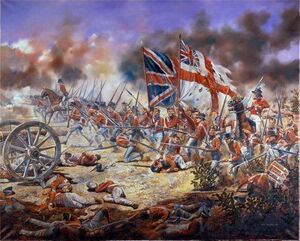Battle of Bengaluru
The Battle of Bengaluru (15 October 1821 - 25 October 1821) was fought at Bengaluru from 15 October to 25 October. The battle would prove to be the climax of the 1821 Maharashtra-Andhrapradesh Campaign and would determine the fate of both sides. The battle would be the largest fought in Indiae until the Second Europan War.
With the Coalition forces continued to be routed, General Sir. Benedict Humeray remained determined to prevent the advance of the Aurucolians and the Sikhs to the vital Port of Pondecherry. The battles prior to Bengaluru; the Battle of Bhangare knocked the Galbadians out of the campaign and sent Field Marshal Georg Ludwig Koppel's Galbadian forces into retreat while the Battle of Mysoru, while a victory for the Lucians, prevented General David Auchinleck from reinforcing Humeray at Bengaluru. Marshal Flórián Székely de Kisbátor ordered Generals Perunović and Rácz to continue engaging the retreating Galbadians and prevent the Lucians from reinforcing Humeray respectively. With this, the Coalition forces at Bengaluru were heavily outnumbered.
In 15 October, Kisbátor commenced the attack. Unfortunately for the Sikhs and Aurucolians, Humeray's mass retreat in August granted Humeray enough time to prepare defences at Bengaluru. The Aurucolians and Sikhs were shocked to find that despite their overwhelming numbers, the defending Coalition forces were remained determined not to yield a single ground. The defenders had the high ground and Humeray knew that it was the best place to defend Pondecherry from. For the next 5 days, the defenders held their ground. In 20 October, Hyderabad forces under the Aurucolians revolted and many switched sides when Humeray took advantage of the situation. However, in 21 October, Kisbátor sent reinforcements and forced the Lucians back to their defences. On the night of the same day, the news of the defeat of the Sikh and Aurucolian fleet at the hands of the Royal Navy at the Naval Battle of Pondecherry reached the Sikh and Aurucolian commanders. Kisbátor realised that without the fleet, his plan was doomed. He was to push to Pondecherry on his own.
The following day at the afternoon, David Auchinleck's forces arrived on the battlefield just 5 kms away from Lucian and Colonial positions at Bengaluru. The arrival of Auchinleck's forces was due in fact that Auchinleck faked a withdrawal, which General Rácz pursued. However, Rácz's forces were met with Galbadian colonials and natives at the Battle of Coimbator while Auchinleck turned his army at 90 degrees to march to Bengaluru to reinforce Humeray. The fate of the Sikhs and Aurucolian forces in the battle were sealed when Field Marshal Koppel's Galbadian Army had also turned around to reinforce Humeray instead of retreating to Goa. The Galbadians engaged with the rear of the Sikhs and the Aurucolians at the Battle of Rankati, thereby effectively almost surrounding the attacking forces. Realising this, Humeray pushed the bulk of his army to the Sikhs and Aurucolian forces, who were now in disarray following Koppel's arrival. Kisbátor ordered a retreat with the remaining forces that were still intact.
The battle dealt a decisive blow to the Sikhs and Aurucolians, who were expecting Pondecherry to fall and the Coalition forces to give way. The Sikhs and Aurucolians would continue to suffer losses and defeats until the end of the campaign with the Fall of Chindewara.
